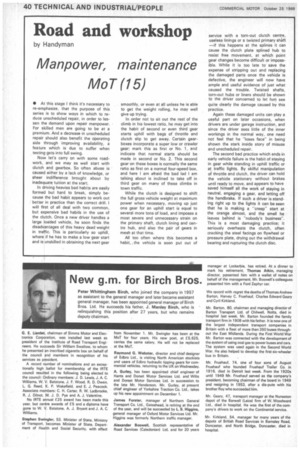Road and workshop
Page 42

If you've noticed an error in this article please click here to report it so we can fix it.
by Handyman
Manpower, maintenance MoT (15)
• At this stage I think it's necessary to re-emphasize, that the purpose of this series is to show ways in which to reduce unscheduled repair, in order to lessen the demand upon repair manpower. For skilled men are going to be at a premium. And a decrease in unscheduled repair should also benefit the operating side through improving availability, a feature which is due to suffer when testing gets into full swing.
Now let's carry on with some roadwork, and we may as well start with clutch and gearbox. So often abuse is caused either by a lack of knowledge, or sheer indifference brought about by inadequate tuition at the start.
In driving heavies bad habits are easily formed but hard to break, simply because the bad habit appears to work out • better in practice than the correct drill. I will first of all deal with two common, but expensive bad habits in the use of the clutch. Once a new driver handles a large loaded vehicle, he soon finds the disadvantages of this heavy dead weight in traffic. This is particularly so uphill, where if he has to make a low gear start and is unskilled in obtaining the next gear smoothly, or even at all unless he is able to get the weight rolling, he may well give up trying.
In order not to sit out the rest of the climb in his lowest ratio, he may get into the habit of second or even third gear starts uphill with bags of throttle and clutch slip to get away. Certain gearboxes incorporate a super low or crawler gear; mark this as first or No. 1, and indicate that normal starts should be made in second or No. 2. This second gear on these boxes is normally the same ratio as first on a normal four-speed box, and here I am afraid the bad lad I am talking about is inclined to take off in third gear on many of these climbs in town traffic.
While the clutch is designed to shift the full gross vehicle weight at maximum power when necessary, moving up just one gear for an uphill start is equal to several more tons of load, and imposes a most severe and unnecessary strain on the primary shaft, clutch lining and centre hub, and also the pair of gears in mesh at that time.
All too often where this becomes a habit, , the vehicle is soon put out of service with a torn-out clutch centre, useless linings or a twisted primary shaft —if this happens at the splines it can cause the clutch plate splinecl hub to resist free movement, at which point gear changes become difficult or impossible. While it is too late to save the expense of stripping out and replacing the damaged parts once the vehicle is defective, the engineer will now have ample and useful evidence of Just what caused the trouble. Twisted shafts, torn-out hubs or liners should be shown to the driver concerned to let him see quite clearly the damage caused by this practice.
Again these damaged units can play a useful part on later occasions, when drivers are under garage instruction, and since the driver sees little of the inner workings in the normal way, one need not feel that he "loses facein being shown the stark inside story of misuse and unscheduled repair.
The second bad practice which ends in early vehicle failure is the habit of staying in gear while standing in uphill traffic or at traffic lights. By skilful manipulation of throttle and clutch, the driver can hold the vehicle stationary without brakes until ready to move, and appears to have saved hirnself all the work of staying in neutral, engaging a gear, and letting off the handbrake. If such a driver is standing right up to the lights it can be seen that he is making a -creep" start at orange almost, and the smell he leaves behind is "nobody's business". This is a most damaging practice; it seriously overheats the clutch, often cracking the steel facings on flywheel or pressure plate, drying out the withdrawal bearing and rupturing the clutch disc.
the
















































































































